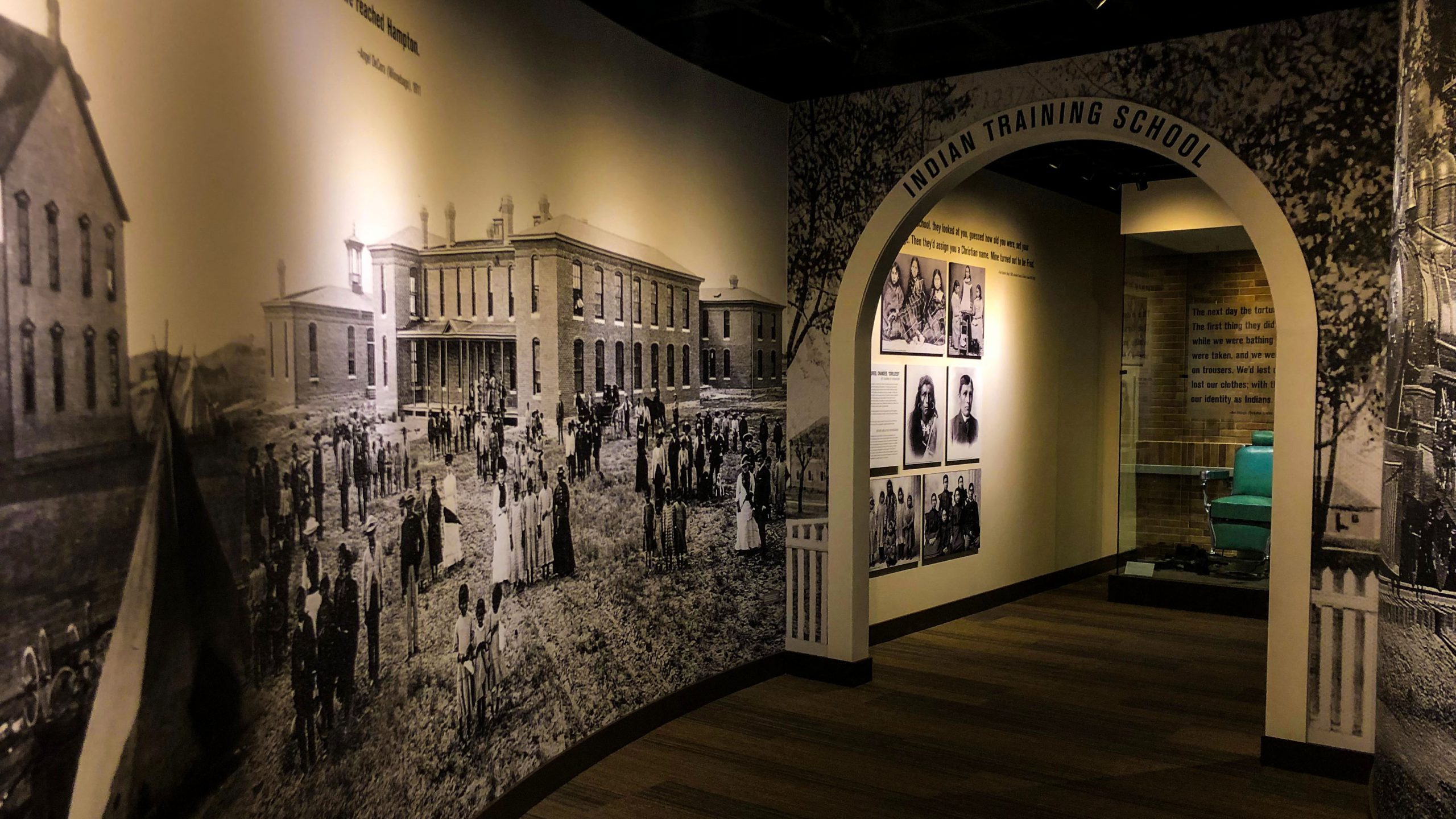Indianz.Com > News > Cronkite News: Projects document Indian boarding school experience

‘We are survivors’
National, Arizona projects aim to uncover, preserve histories of Native American boarding schools
Thursday, January 18, 2024
Cronkite News
PHOENIX — A national oral history project aims to document the experiences of Indigenous children who attended federal boarding schools. The Department of the Interior announced the project in September as part of the Federal Indian Boarding School Initiative.
The National Native American Boarding School Healing Coalition (NABS) has been entrusted to lead the project with $3.7 million in grant funding through the Bureau of Indian Affairs and the National Endowment for the Humanities.
“NABS is an organization that does this work already and approaches the interviewing in a healing-centered approach to really care for our relatives and the survivors of Indian boarding schools,” Melissa Powless, senior director of the NABS oral history project, said. “Healing is a large part of the intent and efforts.”
The project is designed to take place over two years, and the grant will provide for resources and staffing, according to Powless.
Arizona ranks second in the country for the number of boarding schools that have operated in the state – 59, behind Oklahoma’s 95 – according to recent research from NABS.
With 22 federally recognized tribes in Arizona, there has already been an effort across the state to collect data, artifacts and stories from boarding schools for research and education.

A boarding school history
Spanish missionaries began arriving in what is now the southwestern United States in the 16th century, aiming to convert the Indigenous people to Catholicism.
The Civilization Fund Act of 1819 authorized funding for organizations to run schools on Indigenous land as an effort to assimilate Indigenous people into European-American religious beliefs and cultural norms.
In 1879 in Pennsylvania, the first government-run boarding school, Carlisle Indian Industrial School, was opened by Lt. Col. Richard Henry Pratt, whose common refrain, according to historical accounts, was: “Kill the Indian, save the man.”
More boarding schools followed suit.
Separating children from their families and cultural traditions was a way the U.S. government attempted to reprogram Indigenous children and further the systematic destruction of Indigenous communities.
Due to a lack of formal recordkeeping, there is no concrete number of how many boarding schools were in operation nationwide, but NABS estimates there have been 523 in operation from 1801 to today.
“The assimilation that took place was under a lot of direct control and abuse,” Powless said.



A local push for preservation
In the mid-1990s, a former associate curator of the Heard Museum, Margaret Archuleta, began research into the history of Native American boarding schools.
After receiving funding from the National Endowment for the Humanities, the Heard Museum opened the exhibit “Remembering Our Indian School Days: The Boarding School Experience” in 2000. It has become one of the museum’s most popular presentations and stands as one of the only in the country dedicated to sharing the full reality of the boarding school experience and expanding research.
The exhibit was only planned to run for about five years, but the overwhelming positive public response – and surprise at how little the general public knew about the topic – encouraged the Heard staff to keep the exhibit and eventually do an update, said Janet Cantley, curator and project manager of the exhibit.
That updated exhibit, “Away From Home: American Indian Boarding School Stories,” opened in 2019 and could not have been as thorough as it was without a six-person advisory committee overseeing content and helping with data collection, according to Cantley.
“In the exhibit, you’re going to see many videos … some of them are interviews from alumni and myself included,” said Talahongva, who served on the advisory committee. “It’s really important to get as many oral histories as possible from the students who went to the schools.”
The exhibit delves into the history of Native American boarding schools while tying in images, music, sound, oral interviews and videos of firsthand records to encapsulate the experiences of those who lived them.




Note: This story originally appeared on Cronkite News. It is published via a Creative Commons license. Cronkite News is produced by the Walter Cronkite School of Journalism and Mass Communication at Arizona State University.
Search
Filed Under
Tags
More Headlines
Native America Calling: Native TikTok users prepare for U.S. ban
Native America Calling: Euchee food, whale hunting and young gardeners on The Menu
Cronkite News: Navajo psychiatrist addresses mental health needs
Chuck Hoskin: Tell the whole story about the theft of tribal lands
Native America Calling: A sample of Native Guitars Tour 2024
Cronkite News: Native organization carries on horse traditions
Native America Calling: How Native literature is changing the mainstream narrative
Native America Calling: No ordinary animal
Native America Calling: Safeguards on Artificial Intelligence
NAFOA: 5 Things You Need to Know this Week
Chuck Hoskin: Cherokee Nation takes the lead for our environment
Native America Calling: Earth Day assessment for Native peoples
Cronkite News: Gathering addresses ‘epidemic’ among Native people
VIDEO: Cody Desautel on tribes and federal forest management
AUDIO: Legislative Hearing on Discussion Draft of Forest Management Bill
More Headlines
Native America Calling: Euchee food, whale hunting and young gardeners on The Menu
Cronkite News: Navajo psychiatrist addresses mental health needs
Chuck Hoskin: Tell the whole story about the theft of tribal lands
Native America Calling: A sample of Native Guitars Tour 2024
Cronkite News: Native organization carries on horse traditions
Native America Calling: How Native literature is changing the mainstream narrative
Native America Calling: No ordinary animal
Native America Calling: Safeguards on Artificial Intelligence
NAFOA: 5 Things You Need to Know this Week
Chuck Hoskin: Cherokee Nation takes the lead for our environment
Native America Calling: Earth Day assessment for Native peoples
Cronkite News: Gathering addresses ‘epidemic’ among Native people
VIDEO: Cody Desautel on tribes and federal forest management
AUDIO: Legislative Hearing on Discussion Draft of Forest Management Bill
More Headlines